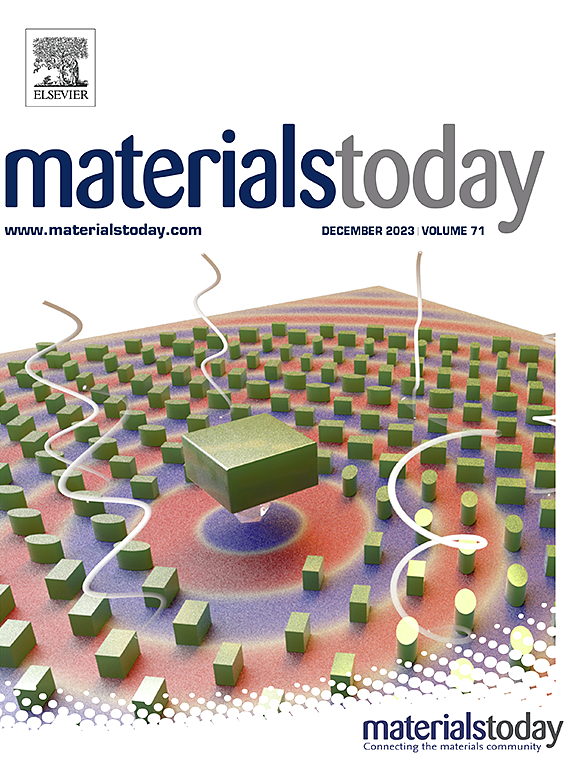Targeted-tuning competitive acidic CO2RR via metalloid antagonism sites
IF 21.1
1区 材料科学
Q1 MATERIALS SCIENCE, MULTIDISCIPLINARY
引用次数: 0
Abstract
To mitigate the high separation costs associated with conventional neutral/alkaline electrocatalysis for CO2 reduction reactions (CO2RR), acidic CO2RR offers economic advantages and improved efficiency in CO2 utilization. However, it typically involves the cleavage of M−H bonds at a relatively negative potential, leading to the predominant formation of H2 and poor HCOOH selectivity. Herein, we develop a facile solid-phase thermal diffusion approach to controllably synthesize a novel metalloid-metal single atom alloys (m-SAAs) electrocatalyst Te1Bi with unique metalloid antagonistic sites, thus enabling high-efficient acidic CO2-to-HCOOH conversion. Electrochemical test and operando synchrotron radiation multi-techniques (SRMS) characterization reveal that metalloid Te sites bring steric hindrance effect and blocks *H coupling. Furthermore, it actively adsorbs OH− species as a proton source, allowing for effective separation of protons and electrons in space. Thus, leading to enhanced hydrogenation in acidic CO2RR to produce HCOOH. The flow cell test results demonstrate that the carefully designed Te1Bi catalyst exhibits a milder reaction potential, along with higher HCOOH Faraday efficiency (∼94.5 %) and single-pass carbon efficiency (SPCE, ∼40 %) in acidic media. This work significantly expands the family of SAAs and offers a novel perspective to analyze the regulation of competitive reactions through site-specific modifications for industrial acidic CO2RR.

通过类金属拮抗位点靶向调节竞争性酸性CO2RR
为了降低传统的中性/碱性电催化CO2还原反应(CO2RR)的高分离成本,酸性CO2RR具有经济优势,并提高了CO2利用效率。然而,它通常以相对负的电位切割M - H键,导致H2的主要形成和较差的HCOOH选择性。在此,我们开发了一种简单的固相热扩散方法来控制合成具有独特的类金属拮抗位点的新型金属-金属单原子合金(m-SAAs)电催化剂Te1Bi,从而实现了高效的酸性co2到hcooh的转化。电化学测试和同步辐射多技术(SRMS)表征表明,类金属Te位点具有空间位阻效应,阻碍了*H偶联。此外,它作为质子源积极吸附OH -,允许在空间中有效地分离质子和电子。因此,导致酸性CO2RR中的加氢作用增强,生成HCOOH。流动电池测试结果表明,精心设计的Te1Bi催化剂在酸性介质中具有较温和的反应电位,以及较高的HCOOH法拉第效率(~ 94.5%)和单道碳效率(SPCE, ~ 40%)。这项工作大大扩展了SAAs家族,并提供了一个新的视角来分析通过工业酸性CO2RR的位点特异性修饰对竞争反应的调节。
本文章由计算机程序翻译,如有差异,请以英文原文为准。
求助全文
约1分钟内获得全文
求助全文
来源期刊

Materials Today
工程技术-材料科学:综合
CiteScore
36.30
自引率
1.20%
发文量
237
审稿时长
23 days
期刊介绍:
Materials Today is the leading journal in the Materials Today family, focusing on the latest and most impactful work in the materials science community. With a reputation for excellence in news and reviews, the journal has now expanded its coverage to include original research and aims to be at the forefront of the field.
We welcome comprehensive articles, short communications, and review articles from established leaders in the rapidly evolving fields of materials science and related disciplines. We strive to provide authors with rigorous peer review, fast publication, and maximum exposure for their work. While we only accept the most significant manuscripts, our speedy evaluation process ensures that there are no unnecessary publication delays.
 求助内容:
求助内容: 应助结果提醒方式:
应助结果提醒方式:


